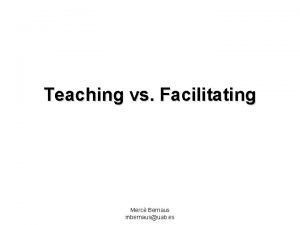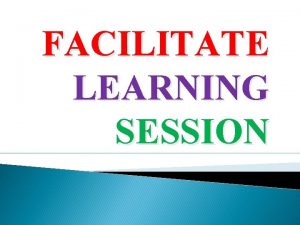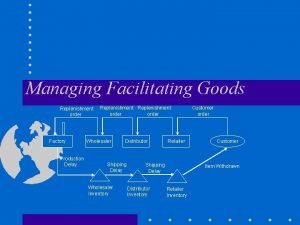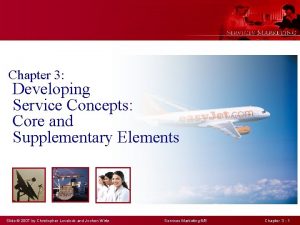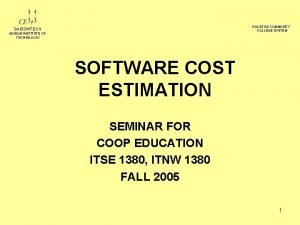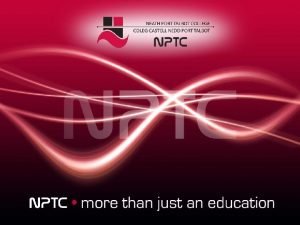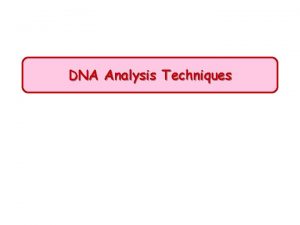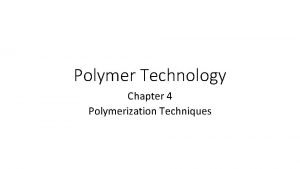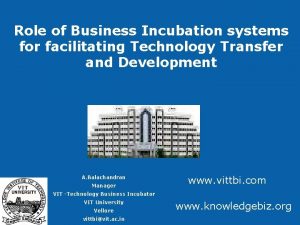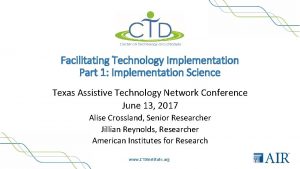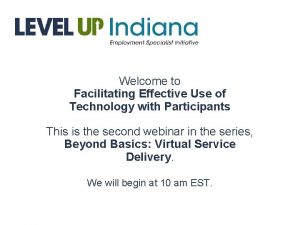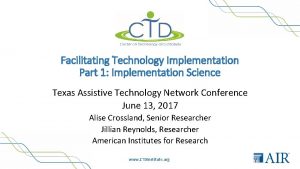Facilitating with Technology New Technology and New Techniques


















- Slides: 18

Facilitating with Technology New Technology and New Techniques to: Increase Project Team Productivity Optimize Individual Time rtaylor@taylor-made-consulting. com pcollins@jordan-webb. net All Rights Reserved 1991 -2000 (312) 664 -1948 (847) 673 -2288

Scenario n Project team needs to make a collaborative decision n Decision is needed within a short time n Team members have limited time for additional meetings Jordan-Webb - All Rights Reserved 1991 -2000

Collaborative Team Activities n In meetings, project teams will perform some or all of the following activities in various combinations and iterations while producing their desired outcomes and deliverables Jordan-Webb - All Rights Reserved 1991 -2000

Collaborative Team Activities Ideation n Organization n Analysis n Evaluation n Integration n Exploration n Proposition n Decision n Jordan-Webb - All Rights Reserved 1991 -2000

Conventional Response (Work Harder!) n Organizing a Project Team Meeting – Anyone who has tried to organize a meeting has probably found out that it is very hard work! – Just trying to agree on a mutually convenient date & time, contacting team members, re-organizing calendars and then re-scheduling when key members cannot attend are some of the more complex aspects. – This is before taking into account the planning of the desired outcomes, deliverables and activities of the meeting. Jordan-Webb - All Rights Reserved 1991 -2000

Conventional Response (Work Harder!) n Organizing a Project Team Meeting – The notion to “work harder” to get things organized ignores the fact that there are technologies and techniques that can allow your team to “work smarter”. – The following worst case scenario represents how the activities at a conventional 5 -day planning workshop might be organized - requiring all participants to be present at all times. Jordan-Webb - All Rights Reserved 1991 -2000

Conventional Action Steps (All Meetings Face-To-Face) n Phase I (face-to-face, synchronous) – Orientation + Ideation + Organization – Analysis + Evaluation n Phase II (face-to-face, synchronous) – Ideation + Organization – Analysis + Evaluation n Phase III (face-to-face, synchronous) – Integration of Phases I & II + Exploration n Phase IV (face-to-face, synchronous) – Exploration + Proposition n Phase V (face-to-face, synchronous) – Proposition + Decision + Closure Jordan-Webb - All Rights Reserved 1991 -2000

Today’s Response (Work Smarter!) n Organizing a Project Team Meeting – The notion to “work smarter” to get things organized utilizes technologies and techniques that transform the concept of a “meeting” that no longer requires everyone to be at the same place, at the same time, for all of the time. – In the new model of a meeting, activities performed while participants are separated can be integrated with activities that teams must perform when they are face-to-face. Jordan-Webb - All Rights Reserved 1991 -2000

Today’s Response (Work Smarter!) n Organizing a Project Team Meeting – The following scenario represents how the activities of a conventional 5 -day planning workshop might be re-organized into both distributed and face-to-face activities, requiring only one (1) day of face-to-face time. – While some of the distributed activities would be conducted at the same time (synchronously), participants could join other distributed activities at any time (asynchronously) Jordan-Webb - All Rights Reserved 1991 -2000

Today’s Action Steps (Distributed + Face-To-Face) n Phase I (distributed, synchronous) – Orientation + Ideation + Organization – Analysis + Evaluation n Phase II (distributed, asynchronous) – Ideation + Organization – Analysis + Evaluation n Phase III (distributed, synchronous) – Integration of Phases I & II + Exploration n Phase IV (sub-grouped, distributed, asynchronous) – Exploration + Proposition n Phase V (face-to-face, synchronous) – Proposition + Decision & Closure Jordan-Webb - All Rights Reserved 1991 -2000

Group Support Technology for Virtual and Distributed Teams n Optimal Utilization of People - Your Most Valuable Resource – Helping Individual Time Management – Supporting Knowledge Management n Optimal Utilization of Time - A Non-Renewable Resource – Reducing Cycle-Time and Expense – Enhancing the Ability to React to Change n Support for Collaborative Decision-Making – Bridging Time & Place Constraints – Providing Structure & Group Memory n Better Outcomes – Asking Better Questions – Getting Better Answers Jordan-Webb - All Rights Reserved 1991 -2000

Groups Across Time and Place Robert Johannsen’s Four Square Model Same Time Same Place Different Time Same Place Same Time Different Place Different Time Different Place Jordan-Webb - All Rights Reserved 1991 -2000

Technology for Group Work n Group Decision Support Systems provide work environments & tools that: – enable groups to do real work in: • the same place - face-to-face • different places - distributed • any place - virtually – enable teams to collaborate at: • the same time - synchronously • different times - asynchronously • any time - virtually Jordan-Webb - All Rights Reserved 1991 -2000

Small Group Technology Support (Synchronous, Same Time - Same Place) Leader Participants have access to shared workspace in a fixed meeting space Jordan-Webb - All Rights Reserved 1991 -2000

Small Group Technology Support (Synchronous, Sub-Grouped, Same Time - Same Place) Leader Sub-Group A Sub-groups have access to shared workspace in a fixed meeting space Sub-Group B Jordan-Webb - All Rights Reserved 1991 -2000 Sub-Group C

Virtual Group Technology Support (Synchronous or Asynchronous, Same or Different Time - Different Place) Leader Participants join from a common workspace or from their own workspace at a mutually agreed upon time or at a time convenient to their own schedule Jordan-Webb - All Rights Reserved 1991 -2000

“Out of the Box” Planning for Virtual and Distributed Teams n Context for out-of-the-box planning – Envisioning or creating group processes that do not exist within our current frame of reference n Current State – Difficult to coordinate individual schedules for face-to-face sessions – Expensive and time consuming to convene teams for multiple days n Desired State – Easy setup for distributed sessions while minimizing face-to-face sessions – Team collaboration from convenient places at convenient times n Bridging the Gap – Enabling facilitators and planners to design new processes that “distribute” certain activities across time and place boundaries when: • such activities might not necessarily require a face-to-face interaction • time constraints make face-to-face interaction impossible • budgetary constraints make face-to-face interaction impractical Jordan-Webb - All Rights Reserved 1991 -2000

Next Steps & Action Items n Contact us and help us learn about Your Organization – Paul Collins (847) 673 -2288 pcollins@jordan-webb. net – Reginald Taylor (312) 664 -1948 rtaylor@taylor-made-consulting. com End Presentation Jordan-Webb - All Rights Reserved 1991 -2000
 Facilitating learning child and adolescent development
Facilitating learning child and adolescent development Teaching vs facilitating
Teaching vs facilitating Facilitate training session
Facilitate training session Facilitating goods examples
Facilitating goods examples Merchant wholesalers
Merchant wholesalers What is channel participants
What is channel participants Importance of marketing channels
Importance of marketing channels Facilitating learning module 2
Facilitating learning module 2 List down the factors influencing communication
List down the factors influencing communication Facilitating cultural change
Facilitating cultural change Lovelock flower of service
Lovelock flower of service Fonction technique scooter
Fonction technique scooter Saigon institute for techniques & technology
Saigon institute for techniques & technology New york, new jersey, pennsylvania, and delaware
New york, new jersey, pennsylvania, and delaware Fresh oil new wine
Fresh oil new wine 3 weaknesses of the articles of confederation
3 weaknesses of the articles of confederation Marketing management kotler keller
Marketing management kotler keller New classical macroeconomics
New classical macroeconomics Chapter 16 toward a new heaven and a new earth
Chapter 16 toward a new heaven and a new earth

